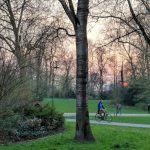Zoning, Infrastructure, and Connection
“Zoning” – The word alone is enough to make a grown person’s eyes glaze over and memory race for reasons to exit the conversation. Rest assured I’m not here to get into the nitty gritty of FARs and setbacks, but as #Biketober speeds past us I think it’s a good time to talk about how zoning, infrastructure large and small, and Livable Buckhead work to wield the arcana of zoning designations to make magic.

Well designed public spaces can bring joy. Just look at Katie!
Walking through the ‘core’ of Buckhead you may notice that the sidewalks are particularly wide, the streetscapes are maintained and almost universally tree-lined. It’s no mistake, in fact it took years of work to establish the set of standards for “SPI-12″ (Special Public Interest [zoning district] number 12) that applies to the dense cluster of office and high-rise residential buildings largely situated around the Buckhead and Lenox MARTA stations. Those specs became mandatory for developers to adhere to in October 2010 and one by one built the connected, hospitable Buckhead of today (though, in some cases projects led by the Buckhead CID brought things up to speed all at once). “Safe and convenient pedestrian circulation”, “use of various transportation alternatives”, and “vibrant streets” are all phrases which appear in the SPI-12 statement of intent.
SPI-12 and Livable Buckhead’s involvement in the Design Review Committee (DRC) ensure that as projects come along that trigger SPI requirements, each one is thoroughly vetted. One ingredient in the potent potion for palatable projects is the added focus on pedestrian connectivity within the district. If you’ve ever made the winding trek from Alliance Center to Monarch Plaza, you’ll have a good feeling for what I mean. Walking between adjacent complexes may seem like an obvious amenity, but the reality is that traditional development processes are very siloed between property owners – there’s often not much reason for neighboring developments to talk, let alone collaborate. Making connectivity a design requirement elevates the quality of development projects and the quality of life for everyone it touches. Other examples of intentional pedestrian connectivity include the access path from Alliance Center to Stratford Road, the decadent sidewalks soon to front the corner of Piedmont and Lenox roads, and of course PATH400 – the 5.2 mile scenic greenway connecting to the Atlanta Beltline at Lindbergh, through the Buckhead Core across GA400, and onto Sandy Springs and points north.
SPI-12 also mandates minimum bike infrastructure and amenities that all new developments of a certain size must provide: as well as a menu of Transportation Demand Management (TDM) strategies for new developments to choose from to help offset their impacts.
The benefits of such a connected neighborhood are plentiful and not always as obvious as they seem. For my part, I’ve talked at length about the desirability and virtues of a bikeable built environment. Those benefits even spill over for those who don’t choose active commute options: less traffic (since those who can walk or bike are no longer on the road), better access to lunch spots and short errands that might previously have required getting the car out of the deck, reduced vehicle emissions (ie. cleaner air), and one less quantifiable, but no less important benefit: A public realm that more resembles the community we want.
I’ll be blunt: a vehicle-oriented world is an isolated one. Alone in your car to work, alone in your car back home. Maybe lunch is the interaction with the outside world beyond the office enclave. The best thing we can do for our own physical and mental health is to build the world to integrate physical activity and foster connection with our neighbors. This sounds like a lofty goal for a concept as mundane as zoning; but I like to think in 10 years of SPI-12, Buckhead has reaped a great deal of benefit from putting those ideals into practice.





